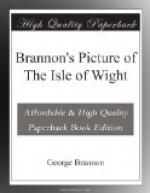Here we pass over an inlet of the sea, indifferently called Fishbourne Creek or Wootton River; the cottages border the road on either side, and have a remarkably clean and comfortable appearance. There are also a few good houses: the Parsonage, though rather secluded, enjoys a charming marine prospect; and Kite-hill will be known by its antique aspect and screen of lofty firs. But the pride of the place is FERNHILL, a first-rate seat: the house is built in the light Gothic style, and stands at the head of an extensive lawn sloping to the water, interspersed with groups of trees and flourishing plantations.
We shall often see the prospect-tower of Fernhill peering above the masses of variegated foliage; and indeed the whole has much the air of a religious structure, enjoying one of those happy localities which distinguished such retreats of former days. The opposite banks of the river, or rather lake, are clothed with the finest oak-woods in the island, feathering from the very water’s edge; and the whole neighbourhood presents the rich appearance of an extensive forest covering hill and dale. Should therefore the visitor reach this spot at the favorable concurrence of high water on a calm sunny day, he will agree with us that the whole forms a splendid landscape,—rock being in fact the only feature denied to make it perfect.
Excellent roads have recently been made (by the proprietor of the estate,) on the west side of the river, below the bridge: affording a very pleasant drive; and as they open many delightful sites, will probably cause a considerable accession of buildings in that direction.
At the mouth of the
creek on the east side is a large hamlet called
FISHHOUSE, including
a dockyard, where several frigates have been
built.
WOOTTON COMMON is a mile nearer Newport: and affords an instance within a few years of a wild tract of gorse and brambles being profitably converted to tillage and garden. Here too are several scattered dwellings forming an improving hamlet; and in one of them (called in courtesy Landscape Cottage,) was produced in all its stages the present little work, as well as its other kindred publications.
About midway between Wootton and Ryde, on the sea side of the road, we pass the remains of
QUARR ABBEY,
The most considerable ecclesiastical establishment ever founded in the Isle of Wight, which had, like every other part of Great Britain, previous to the Reformation, its full share of monastic and other religious institutions. This was among the first settlements of the Cistercian Order in England, having been built in the 12th century; was most amply endowed, and had several illustrious persons buried in the chapel, to whose memory sumptuous monuments were erected; but after its dissolution, the property was purchased by a merchant of Southampton, and the sacred edifice reduced for the value of the bare materials.




